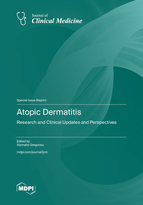Atopic Dermatitis: Research and Clinical Updates and Perspectives
A special issue of Journal of Clinical Medicine (ISSN 2077-0383). This special issue belongs to the section "Dermatology".
Deadline for manuscript submissions: closed (20 February 2023) | Viewed by 33429
Special Issue Editor
Interests: skin cancer; mela-noma and non-melanoma skin cancer; atopic der-matitis; contact dermatitis
Special Issue Information
Dear Colleagues,
Atopic dermatitis (AD), or atopic eczema, is a chronic inflammatory cutaneous disorder. Novel insights in its pathophysiology and breakthrough therapeutics have changed the landscape of AD in the last decade. Genetic polymorphisms, microbiome diversity, skin barrier defects, modulation of innate and adaptive immunity, environmental exposure, and better understanding of the immunologic inflammatory pathways of both eczema and pruritus have shed new light on AD patients phenotypes and endotypes. In addition, several new treatment options, both topical and systemic, including biologics and small molecules, which target selective mediators in the inflammatory pathway have been added to the classical therapies. The aim of this issue is to present the forefront of recent research that has improved our understanding of AD and the new treatment options that are already available or are expected to be available in the near future.
Prof. Dr. Stamatis Gregoriou
Guest Editor
Manuscript Submission Information
Manuscripts should be submitted online at www.mdpi.com by registering and logging in to this website. Once you are registered, click here to go to the submission form. Manuscripts can be submitted until the deadline. All submissions that pass pre-check are peer-reviewed. Accepted papers will be published continuously in the journal (as soon as accepted) and will be listed together on the special issue website. Research articles, review articles as well as short communications are invited. For planned papers, a title and short abstract (about 100 words) can be sent to the Editorial Office for announcement on this website.
Submitted manuscripts should not have been published previously, nor be under consideration for publication elsewhere (except conference proceedings papers). All manuscripts are thoroughly refereed through a single-blind peer-review process. A guide for authors and other relevant information for submission of manuscripts is available on the Instructions for Authors page. Journal of Clinical Medicine is an international peer-reviewed open access semimonthly journal published by MDPI.
Please visit the Instructions for Authors page before submitting a manuscript. The Article Processing Charge (APC) for publication in this open access journal is 2600 CHF (Swiss Francs). Submitted papers should be well formatted and use good English. Authors may use MDPI's English editing service prior to publication or during author revisions.
Keywords
- Atopic dermatitis Biomarkers
- Exposome
- interleukin 4/13
- pruritus
- Th2 response
- treatment
- biologics
- small molecules
- JAK







